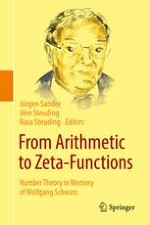2016 | OriginalPaper | Chapter
Recent Developments on the Edge Between Number Theory and Graph Theory
Authors : Jürgen Sander, Torsten Sander
Published in: From Arithmetic to Zeta-Functions
Publisher: Springer International Publishing
Activate our intelligent search to find suitable subject content or patents.
Select sections of text to find matching patents with Artificial Intelligence. powered by
Select sections of text to find additional relevant content using AI-assisted search. powered by
